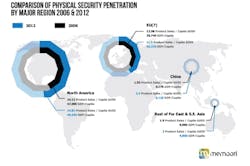Security industry proves resilient in tough economic times
According to a recent report published by UK-based research firm Memoori, the security industry has not only managed to weather the economic storm brought about by the global recession, but is actually thriving and growing.
The "Physical Security Business in 2012" report found that the total value of the world’s security equipment market "at factory gate prices" in 2012 was worth more than $20.5 billion. Among the different product segments, video surveillance products accounted for the majority of the market at 49 percent ($10 billion), followed by intruder alarms at 27.5 percent (5.77 billion) and access control at 23.5 percent ($4.8 billion).
Overall, Memoori said the world market for security systems grew by six percent in 2012. The growth rate of the video surveillance market was nearly double that at 11.8 percent, while access control grew by 7.2 percent. Within video surveillance, the market for IP products grew at a whopping 30 percent.
That’s not to say, however, that the industry hasn’t felt some of the sting from the poor economy. Memoori said that the value of mergers and acquisitions this year declined by 27 percent to a little over $7.1 billion. The research firm attributed this fall to poor economic conditions, which subsequently reduced the confidence of companies to grow through mergers and acquisitions. However, Memoori is forecasting M&A activity to increase steadily at an annual growth rate of 6.5 percent to 2017.
While the manufacturing industry as a whole has struggled in recent years, the makers of security technology have been able keep their businesses healthy for several reasons, according to Memoori Director Jim McHale.
"I would attribute the security industries resilience over the last four years to two main factors. First, the continued growth in demand from developing markets in Asia, Latin America and Eastern Europe. Second, the industry’s ability to continue to provide innovative products and systems that fulfills the end-users’ requirements and help to drive down their costs," he explained. "The next four years will be just as challenging. If the industry focuses on innovation and delivering return on investment to end-users then I fully expect continued growth."
In effect, Memoori said that security manufacturers have been able to turn the purchase of security equipment from a cost center into a cash generator by developing products that help end-users reduce their operating expenses. There have also been some structural changes that have taken place in the industry as it has changed to meet end-user demands, which include the emergence of small and mid-sized companies increasing the size of the market.
"The minnows are taking on the sharks and winning, both through the development of leading edge products and growth through acquisition and alliances," McHale wrote in an article on the report’s findings.
In addition, Memoori also found that security systems integrators have become more involved in the development of products with manufacturers. In fact, McHale said integrators are now taking nearly 50 percent of all product sales.
Demand for security technology in the aforementioned emerging markets, particularly Asia, are also beginning to take market share away from the developed markets of North America and Western Europe. McHale said that Asia has already increased its share of the physical security systems market to more than 35 percent and that China is expected to be the single largest market by the end of the decade.
"The measure of penetration of physical security products in any country is an important factor because it sets a benchmark for the latent potential that is available to exploit. There is an enormous latent demand waiting to be exploited in the emerging markets of the world, confirming that these are the markets that manufacturers should be developing now because they will grow at much higher rates than the developed markets of the western world," wrote McHale. "China, for example, currently has a penetration of one sixth of the USA, but this stood at one tenth in 2011, showing that the market is growing rapidly by taking up this latent potential."
Memoori expects the overall market to grow at a compound annual growth rate (CAGR) of five percent over the next five years.
"The security industry is now in a much healthier state with a product portfolio that can deliver more attractive opportunities for their clients to improve security and at the same time profit from it. This together with the unstoppable growth of IP video network and access control coupled with management identification and verification will drive the market forward," McHale wrote.
For more information about the report, visit http://memoori.com/physical-security-2012.
About the Author
Joel Griffin
Editor-in-Chief, SecurityInfoWatch.com
Joel Griffin is the Editor-in-Chief of SecurityInfoWatch.com, a business-to-business news website published by Endeavor Business Media that covers all aspects of the physical security industry. Joel has covered the security industry since May 2008 when he first joined the site as assistant editor. Prior to SecurityInfoWatch, Joel worked as a staff reporter for two years at the Newton Citizen, a daily newspaper located in the suburban Atlanta city of Covington, Ga.

